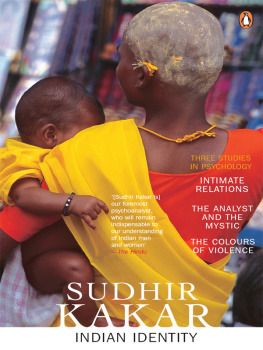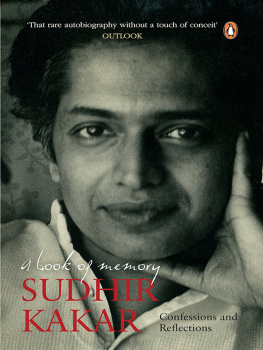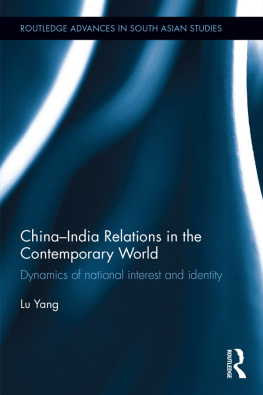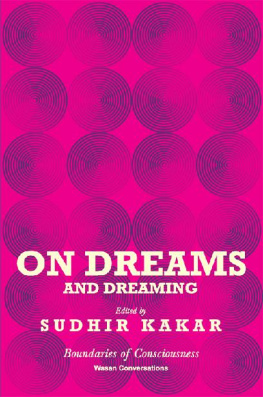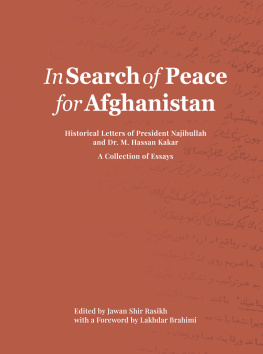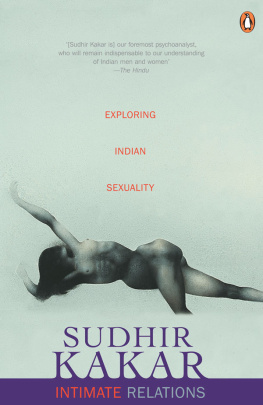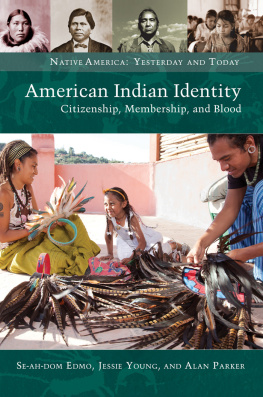Kakar - Indian Identity
Here you can read online Kakar - Indian Identity full text of the book (entire story) in english for free. Download pdf and epub, get meaning, cover and reviews about this ebook. City: India, year: 2013;2007, publisher: Penguin Books Ltd, genre: Home and family. Description of the work, (preface) as well as reviews are available. Best literature library LitArk.com created for fans of good reading and offers a wide selection of genres:
Romance novel
Science fiction
Adventure
Detective
Science
History
Home and family
Prose
Art
Politics
Computer
Non-fiction
Religion
Business
Children
Humor
Choose a favorite category and find really read worthwhile books. Enjoy immersion in the world of imagination, feel the emotions of the characters or learn something new for yourself, make an fascinating discovery.
- Book:Indian Identity
- Author:
- Publisher:Penguin Books Ltd
- Genre:
- Year:2013;2007
- City:India
- Rating:3 / 5
- Favourites:Add to favourites
- Your mark:
- 60
- 1
- 2
- 3
- 4
- 5
Indian Identity: summary, description and annotation
We offer to read an annotation, description, summary or preface (depends on what the author of the book "Indian Identity" wrote himself). If you haven't found the necessary information about the book — write in the comments, we will try to find it.
Kakar: author's other books
Who wrote Indian Identity? Find out the surname, the name of the author of the book and a list of all author's works by series.
Indian Identity — read online for free the complete book (whole text) full work
Below is the text of the book, divided by pages. System saving the place of the last page read, allows you to conveniently read the book "Indian Identity" online for free, without having to search again every time where you left off. Put a bookmark, and you can go to the page where you finished reading at any time.
Font size:
Interval:
Bookmark:

Intimate Relations
The Analyst and the Mystic
The Colours of Violence

PENGUIN BOOKS
UK | Canada | Ireland | Australia
New Zealand | India | South Africa
Penguin Books is part of the Penguin Random House group of companies whose addresses can be found at global.penguinrandomhouse.com.

This collection published 1996
Copyright Sudhir Kakar 1996
The moral right of the author has been asserted
Jacket images Dinesh Khanna
ISBN: 978-0-143-10186-4
This digital edition published in 2016.
e-ISBN: 978-8-184-75073-7
This book is sold subject to the condition that it shall not, by way of trade or otherwise, be lent, resold, hired out, or otherwise circulated without the publishers prior consent in any form of binding or cover other than that in which it is published and without a similar condition including this condition being imposed on the subsequent purchaser.
PENGUIN BOOKS
An internationally renowned psychoanalyst and writer, Sudhir Kakar has been a visiting professor at the universities of Chicago, Harvard, McGill, Melbourne, Hawaii and Vienna, and a Fellow at the Institutes of Advanced Study, Princeton and Berlin. Currently, he is Adjunct Professor of Leadership at INSEAD in Fontainbleau, France. His many honours include the Bhabha, Nehru and National Fellowships in India, the Kardiner Award of Columbia University, the Boyer Prize for Psychological Anthropology of the American Anthropological Association, and Germanys Goethe Medal. The leading French magazine Le Nouvel Observateur listed him as one of twenty-five major thinkers of the world.
Sudhir Kakars books, both non-fiction and fiction, have been translated into twenty languages. His non-fiction works include The Indians: Portrait of a People; The Inner World: A Psychoanalytical Study of Childhood and Society in India; Intimate Relations: Exploring Indian Sexuality; The Analyst and the Mystic: Psychoanalytic Reflections on Religion and Mysticism and The Colours of Violence. His three published novels are The Ascetic of Desire, Ecstasy and Mira and the Mahatma. He has also translated (with Wendy Doniger) Vatsyayanas Kamasutra.
To the memory of Erik H. Erikson, shared with my two dear friends,
John Ross and Pamela Daniels.
In the memories of my childhood, the season is always summer. Blazing hot, dry, and invariably dusty, it is the special summer of small district towns in West Punjab, an area that now lies in Pakistan. Each of the townsDera Ghazi Khan, Multan, Lyallpur, Sargodhawhere we would live for two to three years before my father was transferred to another town, indistinguishable from the one we had just left, have coalesced in my memory into one quintessential town. This is a town without character, neither old nor new, and no one is interested in its past history or its future prospects. Through the nostalgic haze of childhood, I can still summon up images of the towns cheerful dirtiness: its narrow, crowded bazaars lined with open, flowing gutters carrying childrens pee, vegetable peelings and eggshells bobbing on the surface of the inky-black water. I can see the flies clustering on mounds of raw brown sugar in eating places where the chipped enamel plates with their blue borders are never clean enough and the smell of fried onions, garlic, cardamom, cloves and turmeric is embedded in the very walls.
The town is also the central market for surrounding villages. After the harvest, ox-carts loaded with gunny bags full of wheat or stacked high with sugarcane stream in. Their arrival is announced by the chiming of small bells that hang around the necks of the oxen drawing the cart, placidly ignoring the mangy, yelping dogs attempts to provoke them. On market days the farmers are accompanied by their gaily-dressed women and excited children, giving the drab town a touch of shy festivity. These large family groups move deliberately from one shop to another, looking at the wares without expression, unhurriedly bargaining for their small luxuriescoloured glass bangles for the women, a piece of cloth for a childs shirt, a burnished copper pot and brass tumblers for the family kitchen.
As a child, I was as much an outsider to the bazaars as any child from the village. We lived a couple of miles away from the heart of the town in what was called the Civil Lines. The Civil Lines and its military counterpart, the Cantonment, were to be found in many towns. They were creations of the British whose rule was approaching its end in the period of which I write, the early 1940s. The houses in the Civil Lines, built at the end of the last century, were sprawling single-storeyed affairs with acres of ground and a number of servants quarters. Lawns and flower beds, a vegetable garden, a pond or a well, groves of fruit-bearing trees (I particularly remember the blood-red oranges of the grove in Sargodha), were often a part of the estate. Not many Englishmen were now left in these towns. There was the deputy commissioner, of course, the chief representative of the Raj, a virtual lord over the half-a-million or so Indians who lived in the district. Then there was the superintendent of police and perhaps the chief medical officer, who were still Englishmen. All the other higher functionaries of the provincial government living in the Civil Lines, together with a couple of lawyers and doctors, were Indians. My father was one of these Indians, a magistrate dispensing justice in the district court and carrying out the tasks of civil administration in the villages.
Generally, I was content to play within the grounds of the house with my friends, mostly the servants children. Climbing trees to eat unripe guavas that inevitably led to stomach-aches, trying to hit pigeons with pebbles from a slingshot, fishing in the pond for non-existent fish with a thread tied to a twig at one end and a bent pin at the other, the secret delights (and fears) of sexual games with Shanti, the sweepers six-year old daughter in one town and Kishen, the washermans precocious five-year old in another, kept me happy enough. The visits to the towns bazaars were outings I thoroughly enjoyed but did not desperately long for. Whenever I did go to the bazaar, though, accompanying a servant on a shopping errand, I quite liked being pampered by the shopkeepers, who all knew me as the magistrate sahibs son. I took this pampering for granted and confused it with the love I felt was my due as the only son of doting parents.
The pamperings continued in the village to which I often accompanied my father on his official tours. These tours, lasting from a week to a fortnight, were virtual expeditions. Bullock carts, and (in some districts) camels, loaded with tents, camping equipment and foodstuff, set off early in the morning while we followed more leisurely with a retinue of servants, policemen and court clerks. By the evening we would reach our destination, a village where my father would inspect the records, hear complaints and adjudicate disputes. In the falling darkness, which became magically alive with moving pinpoints of light given off by fireflies, cooking fires were lit, pleasantly scenting the air with the smoke from burning wood and buffalo-dung cakes. A stream of visitors and favour-seekers from the village would call on my father in our tent. From hundreds of years of experience as a conquered people, the villagers were well-versed in the arts of flattery, and making complimentary remarks about me was a part of their practised repertoire. By the age of six, I knew that the fawning I received from others in our retinue or from the villagers, was not always love, and that I was not the centre of everyones world; of course, my sister had been born by then.
Font size:
Interval:
Bookmark:
Similar books «Indian Identity»
Look at similar books to Indian Identity. We have selected literature similar in name and meaning in the hope of providing readers with more options to find new, interesting, not yet read works.
Discussion, reviews of the book Indian Identity and just readers' own opinions. Leave your comments, write what you think about the work, its meaning or the main characters. Specify what exactly you liked and what you didn't like, and why you think so.

